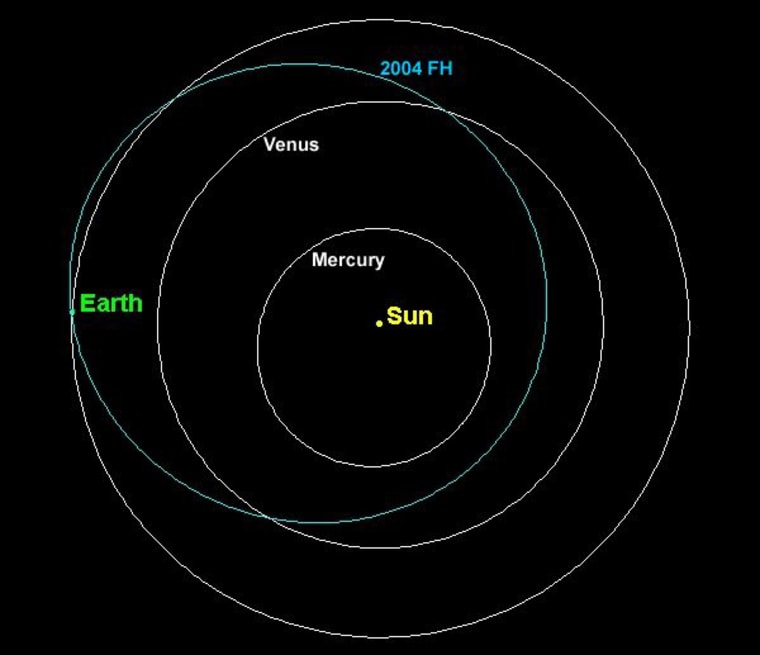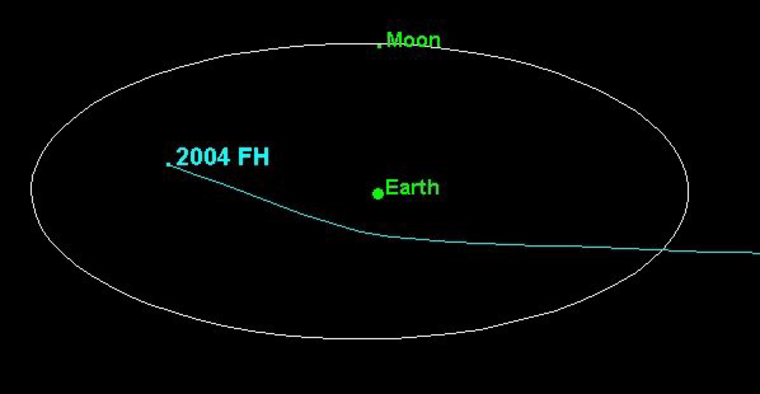An asteroid passed closer to Earth than any previously recorded, but the planet was not at risk, NASA scientists announced.
The space rock is about 100 feet (30 meters) wide. It passed just 26,500 miles (43,000 kilometers) over the southern Atlantic Ocean at 5:08 p.m. ET Thursday. That's about 3.4 times Earth's diameter. It's also just beyond geostationary weather satellites, which orbit at an altitude of 22,300 miles (35,700 kilometers).
Scientist said experienced backyard stargazers should have been able to see it with binoculars or small telescopes from much of Asia, Europe and the Southern Hemisphere, assuming that the skies were clear.
The object, named 2004 FH, was detected Monday.
"It's a guaranteed miss," astronomer Paul Chodas, of the Near Earth Object Program office at NASA's Jet Propulsion Laboratory, said Wednesday.
As it flew past Earth, the path of 2004 FH was bent about 15 degrees by Earth's gravity. It was zooming from one side of the moon's orbit to the other in 31 hours. Astronomers swung telescopes toward the newfound object for what they considered an unprecedented opportunity to study a space rock up close.
An object of this size, were it to take direct aim, would likely break apart or explode in the atmosphere, astronomers say. The result could cause local damage. Something just slightly larger could survive to the surface and destroy a city.
Out there
Most asteroids reside in a belt between Mars and Jupiter, orbiting the sun for eons without leaving that general region. But gravitational interactions kick some inward. It is not uncommon for asteroids to pass near the Earth. It is uncommon to spot them.
Prior to this event, the closest known asteroid flyby was on Sept. 27 last year, when another smallish rock named 2003 SQ222 came within 54,700 miles (88,000 kilometers) of Earth. It was not detected until after it hurtled by. Experts say other similarly sized space rocks pass close about once every two years but go undetected.

Smaller boulders routinely plunge into the atmosphere and vaporize or explode, sometimes dropping fragments to the surface and igniting fires and fears.
Earlier this month, astronomers gathered to pondered the risk of small space rocks that typically are not spotted until they are within hours of possible impacts. Asteroid detections have skyrocketed in recent years, meanwhile, as new electronic cameras increase sensitivity and automated telescopes scan the skies for anything that moves in relation to background stars. Researchers say significant new spending would be required to purposely find and track asteroids smaller than 0.6 miles (1 kilometer).
Meanwhile, asteroid hunters have for the past decade or so focused on finding the larger asteroids, those that could cause global damage. They are not set up to spot all of the smaller objects that inhabit the same general space as Earth. There could be millions. Those that are found involve serendipity.
Lucky find
"The important thing is not that it's happening, but that we detected it," JPL astronomer Steve Chesley said of Thursday's flyby.
The newfound asteroid was detected late Monday by the NASA-funded LINEAR asteroid survey in New Mexico. Follow-up observations were made on Tuesday to confirm the course.
The asteroid circles the sun every nine months, according to calculations by Gareth Williams of the Minor Planet Center in Cambridge, Mass. It swings inside the orbit of Venus and ranges just beyond Earth, moving in roughly the same plane in space through which the planets travel.
Astronomers can't say whether the asteroid might encounter Earth in the future as it continues to orbit the sun.
Spotting 2004 FH would be difficult for most observers. During its closest approach, the asteroid's location in the sky varied greatly depending on a person's exact location on the ground, explains Joe Rao, Space.com's night sky columnist. Seasoned skywatchers can find detailed position information, or ephemeris, at the Minor Planet Center's Web site.
Asteroids aren't the only wanderers to frequent the inner solar system. This spring, two recently found comets are expected to become visible to the naked eye for observers around the world. Meanwhile, casual skywatchers can see all five naked-eye planets right now in the evening sky.
This report includes information from The Associated Press.
